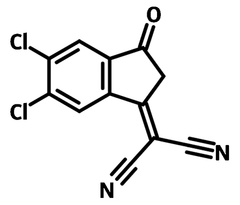2ClIC
CAS Number 2197167-50-1
Chemistry Building Blocks, Materials, Monomers, Non-Heterocyclic Building Blocks2ClIC, high purity building block for non-fullerene acceptors
Free worldwide shipping on qualifying orders
Specifications | MSDS | Literature and Reviews
2ClIC (CAS number 2197167-50-1), namely 2-(5,6-dichloro-3-oxo-2,3-dihydro-1H-inden-1-ylidene)malononitrile, is used as a building block to prepare non-fullerene acceptors (NFAs) such as ITIC-DCl, IEICO-4Cl, IXIC-4Cl and BTP-4Cl for highly efficient non-fullerene organic solar cells (NFOSCs).
Comparing with 2FIC, chlorination is believed to have a more pronounced role in enhancing intermolecular charge transfer (ICT) effect than fluorination does. However, chlorinated NFAs in general have reduced lowest unoccupied molecular orbit (LUMO) levels, leading to reduced open-circuit voltages (VOC) that could cost in general the overall PCE of the resulting OPV cells.
Electron withdrawing building block
For the preparation of non-fullerene acceptors
High purity
>98% pure
Worldwide shipping
Quick and reliable shipping
chloride substituent
Enhances intermolecular charge transfer
General Information
| CAS Number | 2197167-50-1 |
| Chemical Formula | C12H4Cl2N2O |
| Molecular Weight | 263.08 g/mol |
| Full Name | 2-(5,6-Dichloro-3-oxo-2,3-dihydro-1H-inden-1-ylidene)malononitrile |
| Synonyms | IC-2Cl, IC-2CN-2Cl, 2-(5,6-Dichloro-3-oxoinden-1-ylidene)propanedinitrile |
| Classification / Family | Malononitrile, Indanone, Monomer and inermediates, ITIC, None-fullerene acceptors (NFAs), NFA-OSCs, printing electronics |
Chemical Structure

Product Details
| Purity | >98% (by NMR) |
| Melting Point | N/A |
| Appearance | Pale yellow solid |
MSDS Documentation
Literature and Reviews
- Fluorination vs. chlorination: a case study on high performance organic photovoltaic materials, Y. Zhang et al., Sci. China Chem., 61 (10), 1328-1337 (2018); doi: 10.1007/s11426-018-9260-2.
- Over 14% Efficiency in Organic Solar Cells Enabled by Chlorinated Nonfullerene Small-Molecule Acceptors, H. Zhang et al., Adv. Mater., 30, 1800613 (2018); DOI: 10.1002/adma.201800613.
- Achieving over 16% efficiency for single-junction organic solar cells, B. Fan et al., Sci. China Chem., 62, 6 746-752 (2019); doi: 10.1007/s11426-019-9457-5.

 2ClIC MSDS Sheet
2ClIC MSDS Sheet